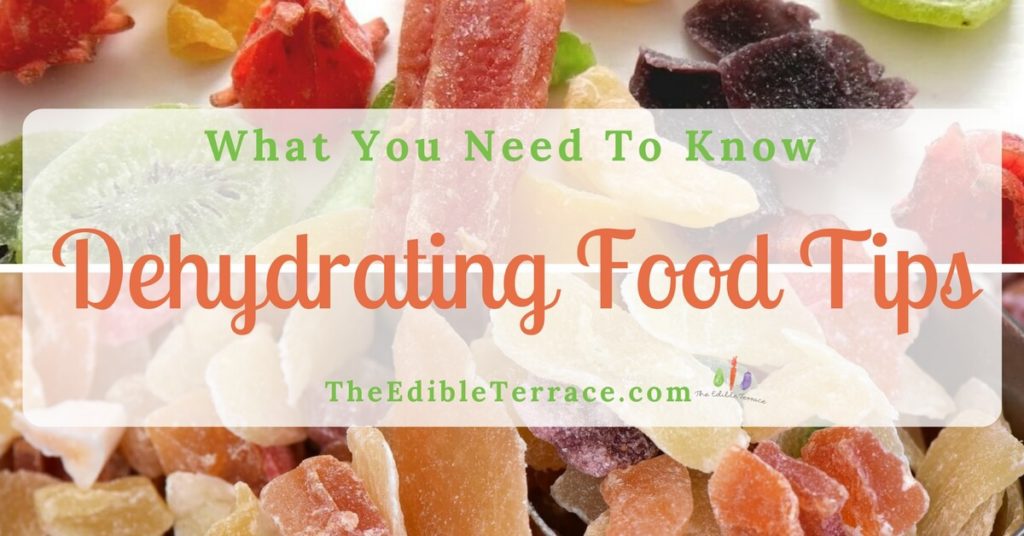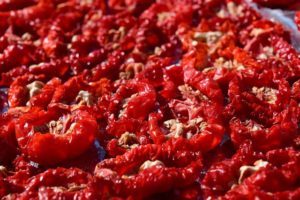Hey! By the way… TheEdibleTerrace is reader-supported. When you buy through links on our site, we may earn an affiliate commission and as an Amazon affiliate, we earn from qualifying purchases. Thanks in advance for your support!

Dehydrating or drying out food is one of the oldest food preservation techniques out there and something that’s making a bit of a comeback in recent years. The idea is to preserve the food by removing as much of the moisture or water content as possible.
Not only will this keep fruits, vegetables, and even meats from spoiling, it also removes a lot of the weight and size of each piece of food. This allows you to store your harvest more easily. Many dehydrated foods can be eaten as is, but you can also soak them in water or another liquid to rehydrate them. The dehydrating food tips below will give you an idea on how and what to do in order to get started.
The reason dehydrating works so well to preserve a large variety of food is because yeast and bacteria need water to grow. By removing all the water from the food, there’s no way for these microorganisms to thrive, thus leaving your food well preserved.
You can dry food in the hot sun, in the oven, or with a dehydrator.
The oven is a great place to get started, while a dehydrator will give you better control and lower settings that result in tastier dried foods. I have included a couple links recipes below for you to experiment with.
1. The optimum temperature for drying food is 140F.
The Ultimate Healthy Dehydrator Cookbook: 150 Recipes to Make and Cook with Dehydrated Foods This may be a little hard to hold even on the lowest setting on your oven. Before you start to do any dehydrating in the oven, I recommend you invest in an oven thermometer. It will help you determine what the actual temperature in your oven is. It will also allow you to turn the heat on and off as needed to stay at or close to the ideal dehydrating temperature.
This may be a little hard to hold even on the lowest setting on your oven. Before you start to do any dehydrating in the oven, I recommend you invest in an oven thermometer. It will help you determine what the actual temperature in your oven is. It will also allow you to turn the heat on and off as needed to stay at or close to the ideal dehydrating temperature.
* The same thermometer can also be very helpful when you’re starting to experiment with solar drying. If you live in a very humid climate, solar drying is not the right method for you.
2. Prevent fruit from turning brown with lemon juice.
The oven will turn your fruit brown. To minimize that, soak your cut fruit in a mixture of half lemon juice, half water for five minutes before you dry it.
3. Cut pieces evenly.
This will ensure your produce has all dried evenly. 1/4 inch is a good width to aim for. If you feel this will be a challenge (raising my hand over here!), then consider picking up this food mandolin from Amazon. It will make your life SO much easier!
4. Put your produce on wax paper before drying.
Lay a sheet of wax paper on to your cookie sheet before putting your fruit and veggie slices on it. This will prevent them from sticking to your pan.
5. Of course you won’t need it if you invest in an electric dehydrator.
Nesco FD-61WHC Snackmaster Express Food Dehydrator All-In-One Kit with Jerky Gun These appliances aren’t as expensive as you may think and easy to order from Amazon or even pick up at your local small appliance store. I recommend you start with one of the smaller models like this one on Amazon. Not only are they less expensive; they also take up a lot less space when not in use.
These appliances aren’t as expensive as you may think and easy to order from Amazon or even pick up at your local small appliance store. I recommend you start with one of the smaller models like this one on Amazon. Not only are they less expensive; they also take up a lot less space when not in use.
Play around and start drying some fruits and vegetables. Get comfortable with the process and more importantly, see how you and your family enjoy the dry food. Do you find yourself snacking on dried fruits and veggie chips?
Do you like rehydrating and cooking with vegetables that have been preserved this way? If not, there is no reason to invest in a larger dehydrator. If, on the other hand, you find yourself using it a lot, and are ready to upgrade, you end up with two different dehydrators that you can run at the same time come harvest and preservation time.
6. Store your dried foods in a sealed bag or container in a cool, dry place.
Dried vegetables can last up to 6 months and fruit can last up to a year assuming you have them stored properly.

7. Examine it before you eat it.
When you get ready to eat your dried produce, check it first for mold and give it a big sniff. If something doesn’t seem right, throw it out.
I hope these dehydrating food tips helped you get started. Once you’re in the know, it is a really simple task that leads to amazing results!
Check out here how to can your produce.
4 Layer Drying Rack Hanging Solar Dehydrator Pack of 9 Premium 14″ X 14″ Non-stick Dehydrator Sheets
Pack of 9 Premium 14″ X 14″ Non-stick Dehydrator Sheets Nesco Fruit Roll Sheets for Dehydrators Set of 2
Nesco Fruit Roll Sheets for Dehydrators Set of 2







